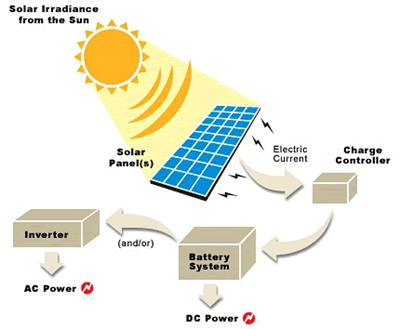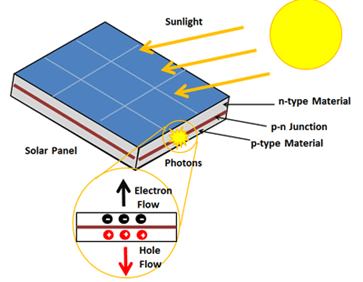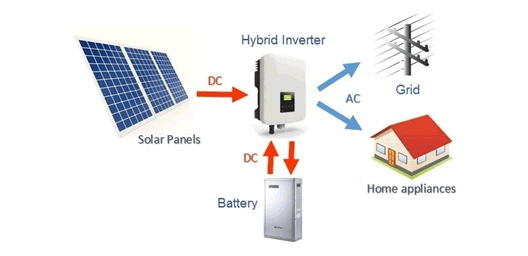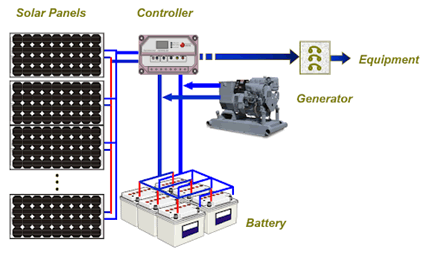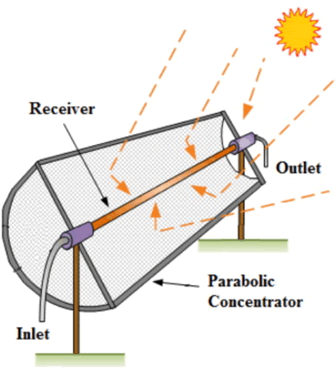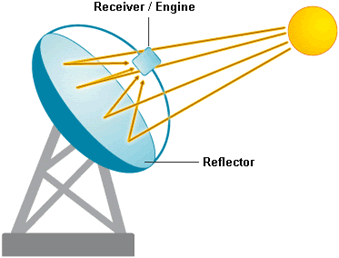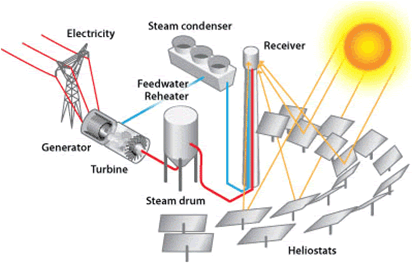Review Article, J Nucl Ene Sci Power Generat Technol Vol: 11 Issue: 4
A Review Study on Solar Energy and Its Various Techniques for Electricity Generation
Prasanna Mishra1*, Pradeep Kumar Verma1, Rishi Sikka Soeit2 and Mukesh Kumar3
1Department of Engineering and Technology, Teerthanker Mahaveer University , Moradabad, Uttar Pradesh, India
2Department of Science and Information, Sanskriti University, Uttar Pradesh, India
3Department of Physical Sciences, SGT University, Uttar Pradesh, Gurugram, Haryana, India
*Corresponding Author:Prasanna Mishra, Department of Engineering and Technology, Teerthanker Mahaveer University, Moradabad, Uttar Pradesh, India, E-mail: prasannamishra234@gmail.com
Received date: 03 November, 2021, Manuscript No. JNPGT-21-46578;
Editor assigned date: 05 November, 2021, PreQC No JNPGT-21-46578 (PQ);
Reviewed date:19 November, 2021, QC No. JNPGT-21-46578;
Revised date: 03 January 2022, Manuscript No. JNPGT-21-46578 (R);
Published date: 21 March 2022, DOI: 10.4172/2325-9809.1000269
Citation: Prasanna M, Pradeep KV, Rishi SS, Mukesh K (2022) A Review Study on Solar Energy and Its Various Techniques for Electricity Generation. J Nucl Ene Sci Power Generat Techno 11:4.
Abstract
Solar energy generates renewable or 'green' power by harnessing the sun's light and heat. Solar power is the most environmentally friendly and plentiful renewable source currently available. Traditional energy harvesting techniques depend on nonrenewable energy sources, which have a major negative environmental effect since they emit a range of harmful and toxic chemicals. Solar energy is among the most good potential and high-quality nonrenewable energy sources. It may be used as a primary energy source as well as for secondary energy production such as electricity and steam. Solar energy has two major benefits: it is inexpensive and generates less pollution. Solar energy is extensively utilized to generate electricity, which is a major use of solar energy. Various Techniques are utilized to change the solar energy into the electrical energy which are discussed in this paper. The purpose of this review study is to give a high-level overview of sun energy and its potential uses as well as Various Electricity Generation Techniques such as generation of electricity through Solar Diesel Hybrid System, Photovoltaic cell and Solar Thermal Power Plant etc. Solar energy has the potential to help fulfill the energy needs of a rising population in the future in a more effective way
Keywords: Electricity, Geothermal energy, Photovoltaic cell, Renewable energy, Solar energy
Introduction
Solar power is a kind of energy that absorbed from the sun and further it is converted into electrical energy. It is the cleanest form of the renewable energy. Renewable energy is derived from source or processes that are rehabilitated on a regular basis. Solar energy, geothermal energy, Wind energy, as well as hydroelectricity are some of these energy sources. Renewable energy resources have being explored at a larger scale to address such challenges. The availability of renewable energy supplies is a key benefit, as is the absence of hazardous gases and other poisonous pollutants. While renewable-energy supplies have the benefit of having limitless supply overtime, their availability at any particular time is restricted. The sun, for example, rises every day, but its capacity to produce electricity is reduced when it is cloudy. Another drawback is that power plant managers will be unable to boost renewable energy production when people use more electricity, such as when a large number of people use air conditioning equipment at the same time on a hot day [1].
We have already used sixty percentage of the entire storage capacity of non-renewable energy resources, which is why further excessive usage of non-renewable energy resources may result in future energy instability. Aside from this issue, one of the primary drawbacks of non-renewable energy resources is the production of hazardous and poisonous gases. The release of these gases into the atmosphere causes environmental harm. Climate change and global warming are caused by rising levels of nitrous oxide, carbon dioxide, carbon monoxide, and Sulphur dioxide [2]. Among all renewable energy sources, solar energy is unique capable for consumption. Solar radiation, which includes infrared, radio waves, UV rays, and gamma rays, among other things, is how the sun's energy reaches the earth. Heat is the most common type of energy emitted by the sun, and it may be utilized for a number of reasons. Solar energy may be used as both a primary and secondary source of energy for the production of electrical energy and steam. Solar-powered power plants are especially useful in rural and other distant locations because they reduce the burden on transmission and distribution lines [3].
One of the most potential applications for addressing the growing need for energy among the world's growing population is power generation. Solar power plants are currently being constructed in both developed and developing nations in order to produce electricity in a more environmentally friendly way. Apart from the many advantages, solar-powered energy production has a number of drawbacks and difficulties. Some of the most common challenges are weather dependency, low efficiency, and a high initial setup cost. To take this technology to the next level, several challenges must be solved. Solar power is the electricity produced by the Sun's solar energy [4]. Although solar power accounts for a tiny proportion of worldwide energy output, it is used extensively in certain nations. China as well as the United States are the global leaders in overall solar energy ability, whereas Germany is a nation that uses solar energy to generate a significant portion of its power. For additional information about solar power across the globe, see the interactive graph below. Capturing sunlight and then using that energy to generate electricity may be achieved in a variety of ways. Solar energy can also be used to warmth domestic water, despite the fact that this page concentrates on photovoltaic cells and solar thermal energy plants [5].
This review article looked at solar energy and its associated components, such as materials, applications, and future prospects. This article will compare and explain how solar energy is better to other renewable energy sources, as well as different techniques for electricity generation through solar. The comprehensive study of solar energy will assist researchers in grasping the fundamentals of solar energy [6].
Literature Review
Solar energy: It is a kind of thermal energy produced by the sun. The major source of thermal energy is the fusion process that occurs on the sun's surface. Because of the numerous disadvantages associated with Non-Renewable power source, the usage of solar power has risen during the last two decades. The high amounts of harmful gas emissions into the environment are one of the major drawbacks of nonrenewable energy sources. It contributes to higher levels of air pollution, which has resulted in a host of problems, including climate change and global warming. In order to tackle such problems, renewable energy has been recognised as one of the greatest capable alternatives to Non-Renewable energy sources. Solar energy from the Sun is dispersed equally in all directions, while other planets, such as Earth, get solar energy from the Sun at different intensities. The distance between the sun and the planet, as well as the planet's atmospheric characteristics, influence the intensity of solar radiation. The different layers of gases and particles that each planet possesses influence the sun's strength [7].
There are two methods to utilize solar energy: as a main energy source: a primary energy source may be utilized directly for a number of purposes. Solar energy may be used directly for cooking and water heating, as well as for the production of secondary energy resources (energy resources produced from primary energy resources or converted from primary energy resources to other energy resources). For example, electricity and steam are two of the most common secondary energy sources. Electricity production is one of the best uses of solar energy, as well as one of the greatest capable. Solar energy-based power production is especially advantageous in rural and isolated areas. It helps in the local generation of power, resulting in a reduction in energy transmission and distribution. It also contributes to the growth of local infrastructure [8].
Applications of solar energy and various techniques for electricity generation: Renewable energy resources have a wide range of applications and may be employed as primary energy resources as well as for the generation of secondary energy resources by converting themselves to energy resources. Solar energy resources, like other renewable energy sources, offer a wide range of uses and may be employed according to the energy need. Some of the application of solar energy as follows [9].
Generation of solar electricity: Photovoltaic cells may generate electric energy or electricity directly from solar energy. A photovoltaic cell is a kind of energy conversion technology that directly transforms photons from sunlight into electricity. Semiconductors absorb photons from the sun and generate high-energy free electrons. An electric field causes these high-energy free electrons to flow out of the semiconductor and do meaningful work. In solar cells, the electric field is generally generated via a p-n junction of materials with differing electrical characteristics. Different manufacturing processes are used to ensure that these cells are as efficient as possible. To construct cell modules, these cells are stacked in a parallel or series configuration. These modules provide a number of distinct benefits, including high reliability, no fuel use, minimal maintenance costs, long life, portability, adaptability, and pollution-free operation as shown in Figure 1.
Solar cells or Photovoltaic cell
Photovoltaic (or solar) technology is a semiconductor device that generates energy using sun radiation. It's a pn-junction semiconductor device made up of 2 kinds of extrinsic semi-conductor materials n-type as well as p-type materials. The n-type semi-conductor material is complete by addition of pentavalent impurities to a pure semi-conductor material. Pentavalent impurities are materials that have five valence electrons in the outermost orbit. Two of the most common pentavalent contaminants are phosphorus and antimony. When a pentavalent impurity is introduced to silicon, for example, all of the valence electrons make covalent bonds with the pentavalent impurity's surrounding four valance electrons, resulting in n-type silicon.
A fifth electron remains unattached to the parent impurity atom and is weakly bonded after the formation of covalent connection between the impurity atom and the pure material atom. These fifth electrons may be released by giving the atom a little amount of energy. In n-type semi-conductor, electrons are the mainstream charge carriers, whereas holes are in the marginal charge carriers, since the extra fifth electrons increases the numbers of free charge carrier in the materials. To make p-type semiconductor material, a trivalent impurity is introduced to pure semiconductor material. Doping is the process of introducing an impurity into a pure semiconductor material. Trivalent impurities have three electrons in the outermost orbit. A vacancy with a positive charge equal to the electron's charge magnitude is created when a trivalent impurity is introduced into a pure semiconductor material. These vacancies, known as holes, act as charge carriers by absorbing electrons. Electrons deliver more current than holes because they have a greater mobility. The mobility of charge carriers in germanium is higher than that of silicon, leading in improved conductivity.
Silicon, on the other hand, is favored over germanium because it is more thermally stable and can tolerate higher temperatures. A pn-junction device, commonly known as a photovoltaic or solar cell device, is produced when these p and n-type semiconductor materials are connected together using the semiconductor unit technique. When the devices are exposed to sunlight, the covalent bonds in both kinds of semiconductor materials are disrupted, resulting in the production of more electron and holes pairs. These charge carriers move in opposite directions because their polarity charges are opposed. The passage of charge carriers in the device causes the current flow in the device (Figure 2).
Solar hybrid system
A hybrid solar power system is made up of both on-grid and off-grid solar panels. It includes a battery backup for storing power and the capacity to send excess energy into the main grid. It implies that even if there is a power outage, your system will continue to function and you will have access to energy. A hybrid system combines solar energy storage with grid connectivity. This solution gives you the option of storing the power produced by your solar system throughout the day in batteries rather than sending it back into the power grid (Figure 3).
Hybrid systems of solar and thermal
Solar PV produces less expensive inconsistent power during the day, but it relies on long-term power producers to provide electricity 24/7 a day. Solar thermal plants with thermal energy storage offer a reliable, long-term energy supply that can run around the clock, seven days a week. They may be utilized as base load plants if more solar energy is gathered in a day to meet load demand. Without the need of costly battery storage, a proper mix of solar energy (thermal storage type) and solar PV may precisely match load variations.
During the day, a solar thermal storage power plant's additional supplemental energy consumption for the operation of collecting thermal energy from the sun is around 10% of its rated capacity. In a mixed solar farm with a hybrid of solar thermal and solar PV plants at a site, this supplemental power requirement may be met with less expensive solar PV plants. For 24 hour base load operation, a solar Photovoltaic plant (33% production) during the day and a solar thermal storage plant (67% creation from solar power tower and parabolic trough types) during the rest of the day may be utilized. When a solar thermal collection plant is forced to shut down due to a lack of sunlight in the area, surplus/infirm electricity from solar PV, wind, and hydro power plants may be utilized to convert stored thermal energy by raising the temperature of molten salt during the monsoon season (similar to a less efficient, bigger storage, and low cost battery storage system).
Solar diesel hybrid system
Solar hybrid system integrates solar energy from a PV with energy from another source. PV diesel hybrid systems, which combine PV with diesel generators, often known as diesel gensets, are one of the most popular hybrid systems. The diesel generators are utilized to bridge the gap among the load as well as the PV system's power generation. Battery storage may help improve overall system performance by ensuring that the quantity of energy available matches demand. Because the capacity of diesel generators is limited and solar energy output is intermittent, an energy management system may be added to optimize the system.
The primary energy source may be grid electricity, a PV system, or a diesel generator, depending on the customer and their circumstances. When it's connected to the grid, we call it an on-grid system, and when it's not, we call it an off-grid system. Those energy sources, in any event, are utilized to complement one another. Whether the aim is to fill up the energy vacuum left by grid failure or to save money on gasoline, a PV system may help. Excess energy may also be stored in batteries to be utilized later. Electrical Power Control, for example, is an energy management system that may guarantee fuel savings and optimum system performance shown in Figure 4.
The advantages of a solar-diesel hybrid system are many
PV penetration has increased: PV solar installations may cause voltage to become unacceptably volatile or out-of-range, thus eOS technologies can be used to help grid operators integrate distributed PV solar.
No energy is wasted: The energy produced throughout the day is not squandered or sent back into the grid with the appropriate equipment. It may be saved and utilized at any time.
- Power That Isn't Interrupted: When the grid goes down or the PV generation is insufficient, the system continues to function.
- Environment-friendly: CO2 emissions are reduced when sustainable resources are used.
Solar thermal power plants
Solar thermal power plants create energy by heating a fluid to a high enough temperature using the Sun's beams. Heat is transmitted from this fluid to water, resulting in superheated steam. In a power plant, steam is utilized to spin a turbine, and the mechanical energy is transformed into electricity via a converter. This method is similar to fossil-fuel-based power production, except that sunlight is used to heat steam instead of fossil fuels. To achieve sufficiently high temperatures, these devices utilize solar collectors to focus the Sun's beams on a single spot.
There are two types of solar radiation collection and storage systems: passive and active. Solar thermal power plants are examples of active systems. Although the majority of these plants are designed to run solely on solar energy, some may need to employ fossil fuels to enhance production
Various types of plants
Solar thermal use mirrors to bounce as well as focus sunlight on a single spot, despite their various shapes and sizes. Solar power is gathered as well as transformed to heat energy, which produce steam and drives a generator at this stage. This results in the generation of energy.
Troughs parabolic
Long, parabolic-shaped reflectors concentrate incoming sunlight onto a pipe flowing down the trough in these troughs, also known as line focus catchers. The collectors may utilize a single-axis Sun-tracking system to monitor the Sun as it travels from across sky from east to west, ensuring that maximum solar energy is incident on the mirrors. The receiver pipe in the center of the trough may reach temperatures of up to 400°C since the trough concentrated the Sun at 30-100 times its normal intensity.
These troughs are placed in rows on a solar field. As it travels through the pipes, the heat transfer in the parabolic dish heats up. Heat energy is transferred to water and high-pressure superheated steam is generated when the fluid returns to the central heat exchangers. This steam then powers a turbine, which in turn powers a generator, which produces electricity. The heat transfer fluid is cooled before being reintroduced to the solar field (Figure 5).
Dishes with Parabolas
These are enormous parabolic dishes that follow the Sun uses motor. This entails supplying the maximum amount of solar energy possible, which is subsequently concentrated at the dish's focal point. The fluid flowing through these dishes may achieve temperatures of up to 750°C, making them much more effective at concentrating sunlight than parabolic troughs. A Sterling engine convert heat into mechanical energy in these systems by compressing cold working fluid as well as letting the heated fluid to expand outward in a piston or flow via a turbine. The mechanical energy is then converted to electricity through a generator (Figure 6).
Solar power tower
Solar power towers are large buildings that act as a central collector for solar energy. They're smack dab in the midst of a gigantic array of mirrors that focus sunlight on a single point in the tower. Heliostats are huge, flat mirror arrays that track the sun. A mounted heat exchanger in the tower warms the heat exchange fluid. The heat condensed at this location might be 1500 times greater than the incident sunlight (Figure 7). The heated fluid is then converted to steam, which is used to power a turbine and generator. One downside of these towers is that, in order to be cost viable, they must be quite large.
Discussion
Academics have been very interested in renewable energy in recent years since it is regarded as the most feasible alternative to nonrenewable energy sources such as natural gas, coal, and nuclear power. Nonrenewable energy sources emit a large amount of harmful gases and other toxic pollutants, all of which have a detrimental effect on the environment. The most serious issue associated with nonrenewable energy resources is air pollution. Air pollution causes a slew of problems, including climate change and global warming. Renewable energy resources, on the other hand, are natural green resources that are abundant in nature. Solar power is regarded one of the greatest capable renewable-energy options for power production among all renewable energy resources. Solar energy has been used to generate power on a greater scale in recent years. Solar cells, solar power plants, solar heat collectors, solar cooking, and solar water heating are some of the most popular solar energy uses. Solar energy may be used directly in certain situations, and it can also be used to generate other energy resources such as electricity and steam. Many industrialized and developing nations have built solar power facilities in recent years to meet the increasing demand for energy.
The conversion of heat energy to electricity is considerably more efficient in these systems because they can generate steam at such high temperatures. Furthermore, since these plants store heat rather than energy, they escape the issue of inefficient energy storage. Heat storage is both more expensive and more efficient than energy storage. These plants can also provide dispatchable baseload power, which is essential since it means they can produces a consistent quantity of energy as well as switch on and off as required to satisfy society energy needs. Moreover, solar thermal are a kind of energy generation technology that is less polluting than generating electricity using fossil fuels. As a consequence, they are one of the most ecologically beneficial methods of energy production. Regardless, these plants have environmental implications, since a full life cycle analysis may disclose all related carbon dioxide emissions from their development. Renewable energy sources, on the other hand, produce much less pollution than fossil fuel plants.
Conclusion
Solar power is one of the greatest promising energy options for meeting the growing need for energy. Solar energy offers a number of benefits over nonrenewable energy sources, including availability and the lack of harmful gas emissions. Solar energy may be utilized without creating environmental damage. In recent years, several power generation companies have been paying careful attention to it in order to shift their dependence from non-renewable energy sources to solar power. Despite its many benefits, solar energy has a number of drawbacks, including a high initial cost, weather dependency, and poor efficiency, to name a few. The huge quantity of acreage mandatory for these plants to function effectively is one of the disadvantages. Furthermore, the water necessity of this types of plants may be seen as a problem, since the generation of sufficient steam requires significant amounts of water. Another potential side effect of employing big focusing mirrors is the harm this plant does to birds. Birds that fly into the Sun's focused rays are at risk of being killed. Approximately one bird dies every two minutes, according to some estimates, at power plants like these. Because sunshine is not accessible in inclement weather or at night, an extra storage system is needed, resulting in a high initial cost for a solar energy-based system. To address these issues, it is suggested that the government provide a suitable framework for the creation of renewable energy-based systems so that costs may be reduced, as well as encourage R and D in this area so that progress can be made on a regular basis.
References
- Nadarajah K, Vakeesan D (2016) "Solar energy for future world A review." Renew. Sustain. Energy Rev 62: 1092-1105.
- Ehsanul K, Sandeep K, Adedeji. (2018) "Solar energy: Potential and future prospects." Renew Sustain Energy Rev 82: 894-900.
- Wahab A, Ali H, Qasim MA, Ali HM. (2019) "Solar energy systems-potential of nanofluids." J Mol Liq 289: 111049.
- Vakulchuk R, Overland I, Scholten D (2020) "Renewable energy and geopolitics: A review." Renewable and Sustainable Energy Reviews 122: 109547.
- Shahbaz M, Raghutla C, Chittedi KR, Jiao Z (2020) "The effect of renewable energy consumption on economic growth: Evidence from the renewable energy country attractive index." Energy 207: 118162.
- Ahmadi Mohammad Hossein, Mahyar Ghazvini, Milad Sadeghzadeh, Nazari Mohammad Alhuyi (2018) "Solar power technology for electricity generation: Crit Rev (N Y)" Energy Sci Eng 6: 340-361.
- Ghadikolaei, Chehreh Saeed Siah. (2021) "An enviroeconomic review of the solar PV cells cooling technology effect on the CO2 emission reduction." Solar Energy 216: 468-492.
- Bhargava AK, Garg HP, Agarwal RK. (1991) "Study of a hybrid solar system-solar air heater combined with solar cells." Energy conversion and Management 31: 471-479.
- Yamegueu D, Azoumah Y, Py X, Zongo N. (2011) "Experimental study of electricity generation by Solar PV/diesel hybrid systems without battery storage for off-grid areas." Renewable energy 36: 1780-1787.
 Spanish
Spanish  Chinese
Chinese  Russian
Russian  German
German  French
French  Japanese
Japanese  Portuguese
Portuguese  Hindi
Hindi 